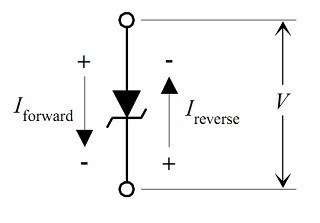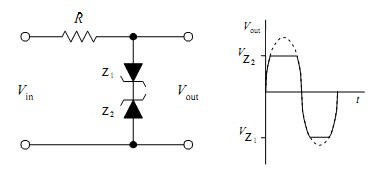Zener diodes are specially designed diodes (heavily doped) that have low reverse voltage breakdown.

Due to this characteristic, Zener diodes are connected backward to regular operation. If Zener is forward biased, it acts as an ordinary diode with a forward voltage drop at 0.6V. Zener diode backward voltage breakdowns may range from 2.4V up to 100V. Honestly speaking, if you need like 1.2V, then probably you need to connect two forward-biased diodes in series for 0.6V+0.6V = 1.2V drop.

In general-purpose diodes, we want reverse breakdown voltage to be as high as possible. In Zener diodes, we want this voltage to be what we need. For instance, we may need a diode breakdown voltage to be 12V. From the characteristic above, we can see that once diode voltage is broken, it stays pretty stable even if the reverse current varies mainly. This is why Zener diodes are commonly used as voltage regulators. Look at the standard regulator circuit.

We can see that circuit is very inefficient, especially when a higher current is needed on output. This is because the current has to flow through diode protection resistor R. Let’s do some interesting calculations to see what’s happening. First of all, let’s select a real Zener diode. For this purpose, let’s chose 1N4728A 3.3V 1W Zener diode. From the datasheet, we can find that the maximum current in the diode is 76mA. So we have to make sure that this current won’t go higher. For this current limiting resistor R is used. Let us calculate the resistor value. Let us say unregulated input voltage is 5V, then the resistor value:
R=(Vin-Vzener)/Izener = (5-3.3)/76mA = 22.7Ω.
As we don’t want to operate at the limits, let’s choose a resistor to be standard 27Ω. This means when no load is applied to output, all current floating through a resistor will flow through Zener as well. With R=27Ω, we get the current 63mA. And thus already we dissipate P = 0.063 * 27 = 1.7W of power on resistor. For battery-operated devices, this is a lot. But wait if we attach the load to output. Say we want to power a microcontroller device with requires 100mA. Then all this current has to flow through the resistor as well. So power dissipation then P = (0.1 + 0.063) * 27 = 4.4W and this goes up when more current is needed by load. The more current, the more resistor turns into the heater. As you can see, resistor power rating has to be selected carefully if you don’t want to see smoke going up. This is why it is better to use specialized voltage regulators in such a case.
But don’t worry, Zener diodes have more uses that are even more important than just voltage regulation. Zeners are also used as amplitude limiters or so-called clippers. They are great to protect input circuits from voltage spikes in signals that could damage further circuit:

When the signal amplitude is lower than the Zener breakdown voltage diodes, it has almost no effect. Still, when the signal exceeds Zener voltage breakdown voltage, it clips the signal to Zener voltage. Also, this is one of the ways to generate a near square signal out of sine.

